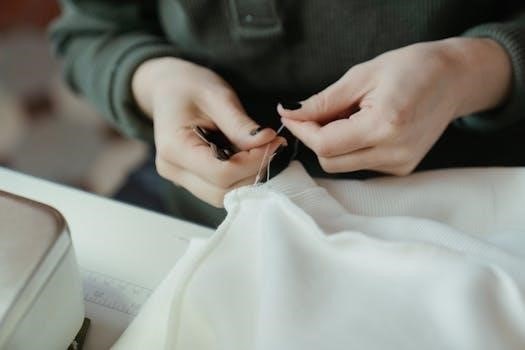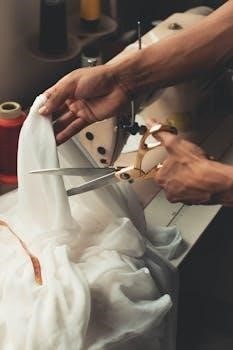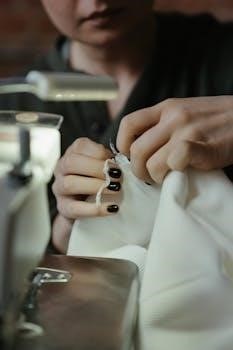brother sewing machine user manual
Brother Sewing Machine User Manual⁚ A Comprehensive Guide
This guide unlocks your Brother sewing machine’s potential, providing detailed operating and maintenance instructions. Access safety guidelines, basic techniques, and troubleshooting tips. Explore features and find resources for optimal sewing experiences. Keep this manual handy for reference.
Accessing and Downloading Manuals
Accessing your Brother sewing machine user manual is straightforward. The latest manuals are readily available on the official Brother support website. Navigate to support.brother.com to find your specific model. You can search by product code or model name for quick access. The site offers various documents, including user guides, instruction manuals, quick reference guides, pattern lists, and stitch charts.
Once you’ve located the correct manual, you can typically download it in PDF format. This allows you to view it on various devices, such as computers, tablets, and smartphones. Adobe Acrobat Reader DC software is recommended for optimal viewing. You can also print the manual for easy reference while you’re sewing.
The Brother Solutions Center provides another resource for finding and downloading manuals. Follow the on-screen prompts to locate your manual and click the download button. Remember that older models may have limited availability. If you cannot find your manual online, consider contacting Brother customer support for assistance. They may have archived copies or be able to provide guidance. Always ensure you have the correct manual for your specific model to avoid confusion or incorrect operating procedures.
Understanding the Importance of the User Manual
The user manual is your essential guide to successfully operating and maintaining your Brother sewing machine. Before using your new machine, carefully read the manual to understand its features and functions. The manual provides crucial safety instructions, helping you avoid potential hazards and ensure safe operation. By following the guidelines, you’ll minimize the risk of injury and prevent damage to the machine.
Beyond safety, the manual details the correct procedures for various sewing operations. From threading the machine to selecting stitches and adjusting settings, the manual offers step-by-step instructions. It explains how to use the machine’s built-in stitches, buttonhole functions, and other features. The manual also provides guidance on basic sewing techniques, enabling you to achieve professional-looking results.
Furthermore, the user manual serves as a valuable troubleshooting resource. It addresses common issues, offering solutions to resolve problems quickly and efficiently. By consulting the manual, you can often avoid unnecessary repairs and maintain your machine’s optimal performance. Regular reference to the user manual will enhance your sewing skills and ensure the longevity of your Brother sewing machine. Keep it accessible for future use.
Key Sections of a Brother Sewing Machine Manual
A Brother sewing machine manual is typically structured to provide clear and comprehensive information. A crucial initial section covers safety precautions, emphasizing potential hazards and safe operating procedures to prevent injury. Next, the manual details the machine’s components, identifying each part and its function, ensuring user familiarity.
A significant portion focuses on basic operations, including threading the machine, winding the bobbin, and selecting stitches. Clear, step-by-step instructions and diagrams guide users through these essential processes. The manual further explains stitch selection, describing various stitch types and their applications. It also addresses adjusting stitch length and width for different fabrics and projects.
Maintenance and cleaning are covered extensively, outlining routine procedures to keep the machine in optimal condition. This section often includes instructions on lubricating moving parts and removing lint. The manual also includes a troubleshooting section, addressing common problems and providing solutions. Finally, it may contain information on optional accessories and advanced features. Understanding these key sections ensures efficient and safe machine use.
Safety Instructions and Precautions
Prioritize safety when operating a Brother sewing machine by adhering to all instructions. Always disconnect the machine from the power outlet before cleaning, servicing, or changing parts like needles or presser feet. Never operate the machine if it has a damaged cord or plug, or if it’s malfunctioning. Ensure the power source matches the machine’s voltage requirements to prevent electrical hazards.
Keep fingers and other body parts away from moving parts, particularly the needle area, to avoid injury. Supervise children and infirm persons closely when the machine is in use. Use the correct needle for the fabric being sewn to prevent needle breakage and potential hazards. Avoid sewing over pins, as this can also damage the needle and machine.

Maintain a clean and well-lit workspace to ensure clear visibility and prevent accidents. Do not use the machine in damp or wet conditions. Store the machine in a safe, dry place when not in use. Regularly inspect the machine for any signs of wear or damage, and have it serviced by a qualified technician if necessary. Following these safety precautions minimizes risks and ensures safe sewing.
Basic Sewing Operations and Techniques

Mastering fundamental sewing operations is essential for successful projects with your Brother sewing machine. Begin by learning how to properly thread the machine, ensuring the thread passes through all guides and the needle correctly. Wind the bobbin evenly and insert it into the bobbin case following the manual’s instructions. Select the appropriate stitch for your fabric and project; straight stitches are for seams, while zigzag stitches prevent fraying.
Practice sewing straight lines on scrap fabric to develop control and evenness. Use the seam guide on the needle plate to maintain consistent seam allowances. Learn to pivot the fabric by stopping with the needle down, lifting the presser foot, rotating the fabric, and resuming sewing. This is crucial for sewing curves and corners.
Understand how to adjust stitch length and width to suit different fabrics and desired effects. Always test your settings on a fabric scrap before starting your actual project. Practice backstitching at the beginning and end of each seam to secure the stitches and prevent unraveling. With these basic techniques, you’ll be well-equipped to tackle a variety of sewing projects with confidence on your Brother sewing machine.
Troubleshooting Common Issues
Encountering problems with your Brother sewing machine can be frustrating, but most issues have simple solutions. A common problem is thread breakage. Check if the machine is threaded correctly, the needle is properly inserted, and the thread tension is appropriately adjusted. Use quality thread compatible with your fabric type to minimize breakage.

Another frequent issue is skipped stitches. Ensure the needle is not bent or damaged and is the correct size for the fabric. Clean the bobbin area to remove lint and debris that can interfere with stitch formation. If the fabric is bunching, reduce the presser foot pressure and check that the feed dogs are properly engaged.
If the machine is making unusual noises, it may need lubrication. Refer to your manual for specific instructions on where and how to oil your machine. If the problem persists, consider taking it to a qualified technician for servicing. By addressing these common issues methodically, you can keep your Brother sewing machine running smoothly and prevent minor problems from escalating into major repairs.
Maintenance and Cleaning
Regular maintenance and cleaning are crucial for keeping your Brother sewing machine in optimal condition and extending its lifespan. Before you begin, always unplug the machine from the electrical outlet to prevent accidents. Start by removing the needle plate and bobbin case. Use a small brush or lint brush to remove lint, dust, and thread scraps from these areas.
Next, clean the feed dogs, ensuring they are free from debris that can affect fabric feeding. Refer to your user manual for instructions on lubricating your machine. Use sewing machine oil specifically designed for this purpose, and apply it sparingly to the designated points. Avoid over-oiling, as excess oil can attract dirt and grime.
Wipe down the exterior of the machine with a soft, damp cloth to remove any surface dirt or smudges. Avoid using harsh chemicals or abrasive cleaners, as these can damage the finish. Store your sewing machine in a clean, dry place, preferably covered, to protect it from dust and moisture. By following these simple maintenance and cleaning steps, you can ensure your Brother sewing machine continues to perform reliably for years to come.
Exploring Advanced Features and Functions
Brother sewing machines often come equipped with advanced features that enhance your sewing capabilities. Consult your user manual to discover the specific functions available on your model. Many machines offer a variety of built-in stitches, including decorative and utility stitches, allowing for creative embellishments and practical seam finishes; Experiment with different stitch lengths and widths to achieve desired effects.
Some Brother machines feature automatic needle threading, simplifying the threading process and saving time. Explore the capabilities of automatic buttonholers, which create perfectly sized buttonholes with ease. Machines with programmable stitch patterns enable you to create custom designs and save them for future use.
Consider features like speed control, which provides greater precision when working on intricate projects; Certain Brother sewing machines are compatible with embroidery units, expanding your creative possibilities. Familiarize yourself with the settings for adjusting thread tension, ensuring balanced stitches on various fabric types. Understanding and utilizing these advanced features will unlock your Brother sewing machine’s full potential, allowing you to tackle more complex and rewarding sewing projects.

Finding Support and Resources
When you need assistance with your Brother sewing machine, a wealth of support and resources are available. Your primary resource is the official Brother support website, which provides access to FAQs, troubleshooting guides, and downloadable manuals. The website often includes video tutorials that demonstrate specific techniques and machine functions.
Brother also offers customer support via phone and email. Consult your machine’s documentation or the Brother website for contact information. Online sewing communities and forums can be invaluable resources for sharing tips, asking questions, and connecting with other Brother sewing machine users.
Local sewing machine dealers often provide repair services and technical support. Consider attending sewing classes or workshops to enhance your skills and learn more about your machine’s capabilities. Many independent sewing blogs and websites offer tutorials and project ideas specifically for Brother sewing machines. Take advantage of these resources to maximize your sewing experience and overcome any challenges you may encounter. Remember, a supportive community and readily available information can make all the difference.
